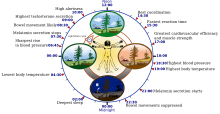
Back Sirkadiese ritme Afrikaans نظم يوماوي Arabic ছন্দঃপূৰ্ণ চক্ৰ Assamese Sirkad ritmi Azerbaijani Циркаден ритъм Bulgarian দেহঘড়ি Bengali/Bangla Jednodnevni biološki ritam BS Ritme circadiari Catalan Cirkadiánní rytmus Czech Rhythm circadaidd Welsh
| Circadian rhythm | |
|---|---|
 Features of the human circadian biological clock | |
| Pronunciation | |
| Frequency | Repeats roughly every 24 hours |
A circadian rhythm (/sərˈkeɪdiən/), or circadian cycle, is a natural oscillation that repeats roughly every 24 hours. Circadian rhythms can refer to any process that originates within an organism (i.e., endogenous) and responds to the environment (is entrained by the environment). Circadian rhythms are regulated by a circadian clock whose primary function is to rhythmically co-ordinate biological processes so they occur at the correct time to maximise the fitness of an individual. Circadian rhythms have been widely observed in animals, plants, fungi and cyanobacteria and there is evidence that they evolved independently in each of these kingdoms of life.[1][2]
The term circadian comes from the Latin circa, meaning "around", and dies, meaning "day". Processes with 24-hour cycles are more generally called diurnal rhythms; diurnal rhythms should not be called circadian rhythms unless they can be confirmed as endogenous, and not environmental.[3]
Although circadian rhythms are endogenous, they are adjusted to the local environment by external cues called zeitgebers (from German Zeitgeber (German: [ˈtsaɪtˌɡeːbɐ]; lit. 'time giver')), which include light, temperature and redox cycles. In clinical settings, an abnormal circadian rhythm in humans is known as a circadian rhythm sleep disorder.[4]
- ^ Edgar RS, Green EW, Zhao Y, van Ooijen G, Olmedo M, Qin X, et al. (May 2012). "Peroxiredoxins are conserved markers of circadian rhythms". Nature. 485 (7399): 459–464. Bibcode:2012Natur.485..459E. doi:10.1038/nature11088. PMC 3398137. PMID 22622569.
- ^ Young MW, Kay SA (September 2001). "Time zones: a comparative genetics of circadian clocks". Nature Reviews. Genetics. 2 (9): 702–715. doi:10.1038/35088576. PMID 11533719. S2CID 13286388.
- ^ Vitaterna MH, Takahashi JS, Turek FW (2001). "Overview of circadian rhythms". Alcohol Research & Health. 25 (2): 85–93. PMC 6707128. PMID 11584554.
- ^ Bass J (November 2012). "Circadian topology of metabolism". Nature. 491 (7424): 348–356. Bibcode:2012Natur.491..348B. doi:10.1038/nature11704. PMID 23151577. S2CID 27778254.
© MMXXIII Rich X Search. We shall prevail. All rights reserved. Rich X Search